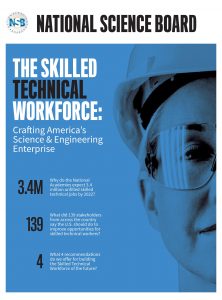October 10, 2019
National Science Board highlights Skilled Technical Workforce shortage in new report
Posted by bphilip
On 12 September, the National Science Board (NSB) released its latest report during a well-attended briefing on Capitol Hill. As the National Science Foundation’s (NSF) governing body, the NSB plays a critical role in looking broadly at trends in the science and technology (S&T) enterprise and provides recommendations to NSF on how to invest its portfolio. The NSB’s latest set of recommendations are presented in The Skilled Technical Workforce: Crafting America’s Science and Engineering Enterprise, which highlights the need for further investment in the Skilled Technical Workforce (STW), which is defined as “workers who use [science and engineering] S&E expertise and technical knowledge in their jobs but who do not possess a bachelor’s degree.” These recommendations – which came after a two-year period of study – were presented at the 12 September briefing by NSB Chair Dr. Diane Souvaine and Dr. Victor McCrary, Chair of the NSB Task force on the STW.
The NSB’s report is motivated by a 2017 study by the National Academies of Sciences, Engineering, and Medicine that projects a shortfall of 3.4 million skilled technical workers by 2022. NSB’s new report recommends filling this gap by placing a greater emphasis on partnerships, improving data collection programs, and rethinking the messaging around the STW as a viable career path. With its recommendations, the NSB aims to re-shape the ecosystem within which STW education occurs and encourages the U.S. to “increase the emphasis on cultivating the STW as part of continued robust support for the education of scientists and engineers.”
To increase participation in the STW, the NSB recommends building awareness of the available skilled career pathways and clearly articulating the advantages of such a career. By improving access to career information, the NSB believes that parents and educators will better advise students, and that this same information will provide mid-career professionals with the knowledge they need to retrain. Additionally, the report recommends that the Federal Government leverage its existing portfolio of STW programs to “maximize the nation’s federal investments in the STW through a holistic, coordinated approach,” and it encourages NSF to produce an analysis of its investments across all directorates, which would allow NSF to “lead by example” by “informing stakeholders about the breadth of NSF’s contributions to the STW.” Lastly, the NSB stresses the need for additional partnerships between higher education, industry, and government. They note that to encourage these collaborations, policymakers should develop “federal programs that require partnership participation from stakeholders from multiple sectors.”
Asked what members of Congress can do to promote the growth of the STW, Drs. Souvaine and McCrary indicated that congresspeople should lead these conversations in their states and districts, with the NSB acting as a willing partner to bring about change. However, the NSB was blunt in its assessment that the coming shortage demands immediate action and that any solution will require participation from the entire S&E community, writing that “we must ‘step up’ our game and nurture and expand our domestic talent along the entire S&E worker-value chain from the STW to the Ph.D. if our workforce is to remain competitive.” Dr. McCrary closed the briefing by describing this challenge as a “Sputnik 2 moment” and predicted that without immediate action, the U.S. risks falling behind other nations that are making significant investments in their S&E workforce and S&T enterprise.
References:
National Science Board. (2019). The Skilled Technical Workforce: Crafting America’s science & engineering enterprise (Report No. NSB-2019-23). Retrieved from https://www.nsf.gov/nsb/publications/2019/nsb201923.pdf
National Academies of Sciences, Engineering, and Medicine. (2017). Building America’s Skilled Technical Workforce. Washington, DC: The National Academies Press. https://doi.org/10.17226/23472.


